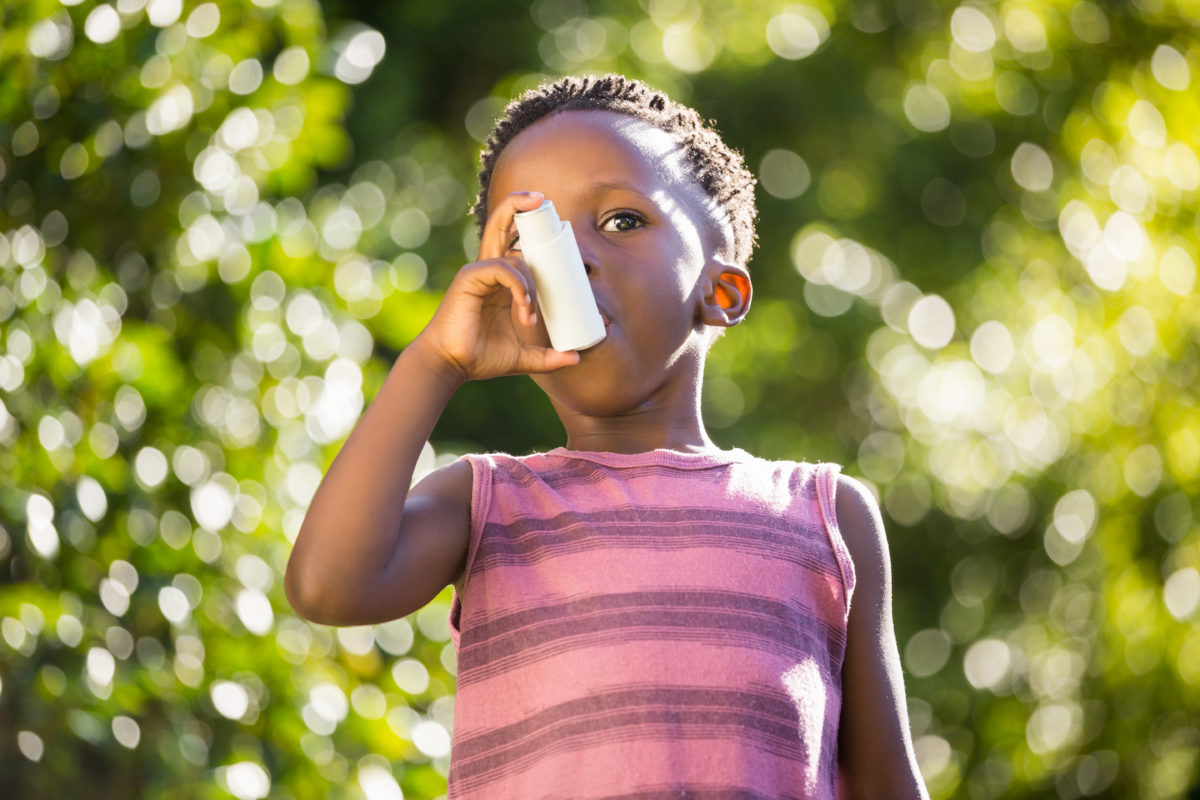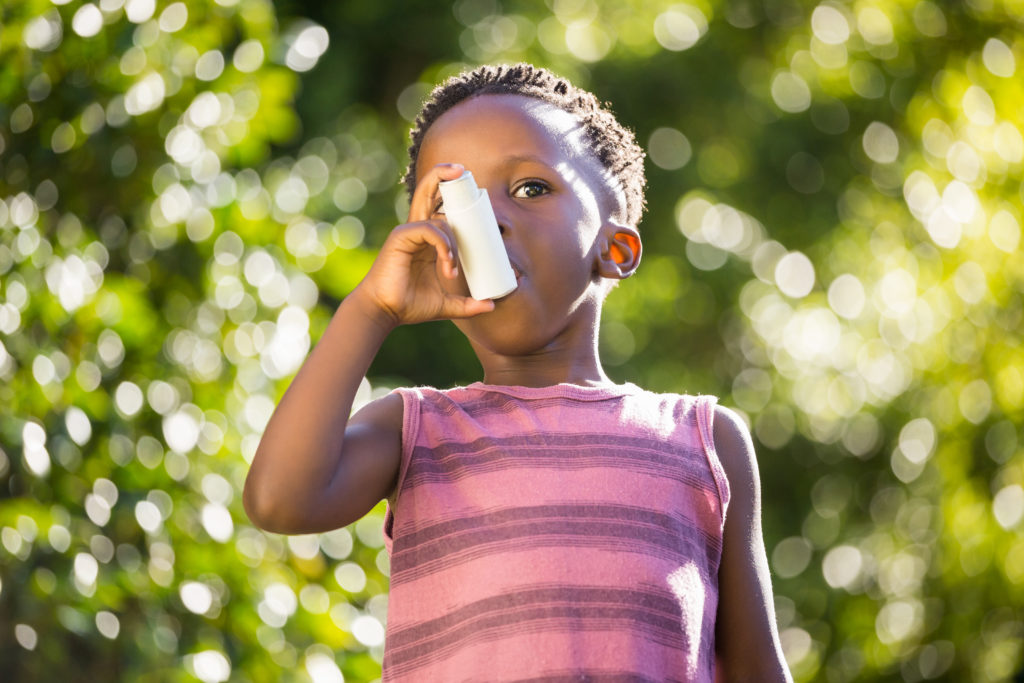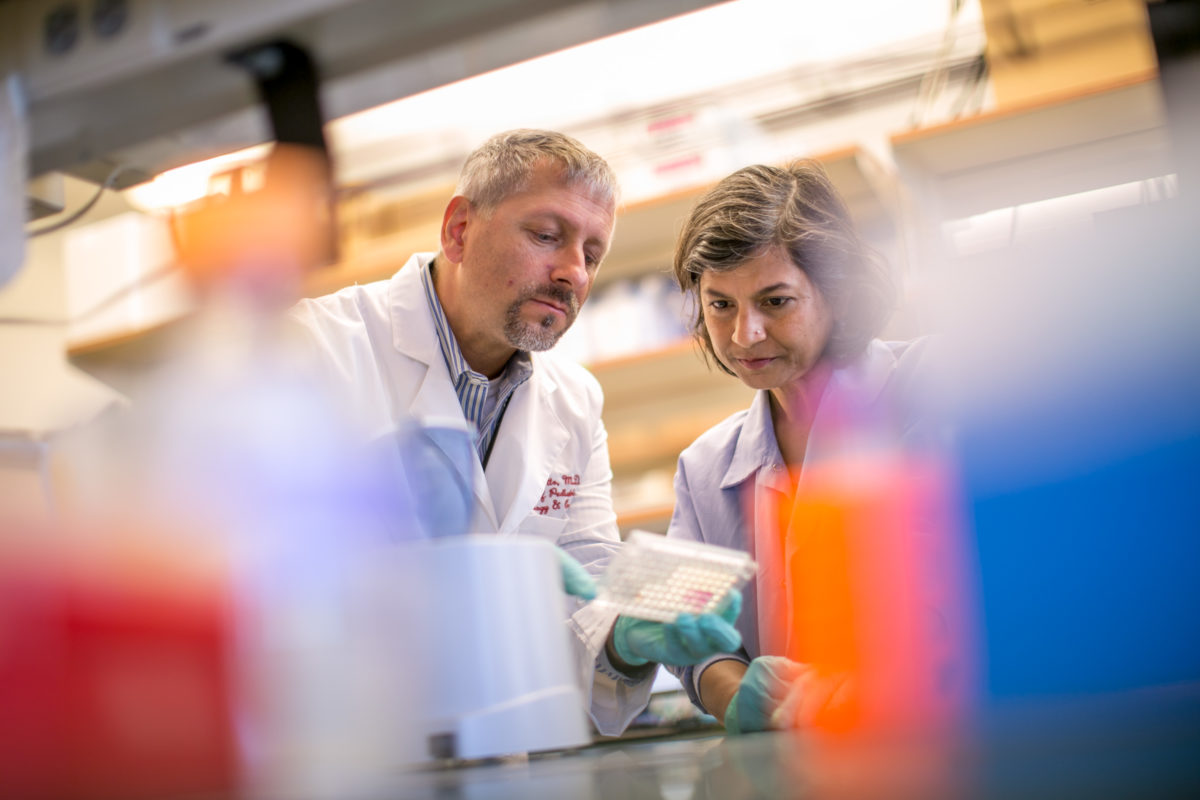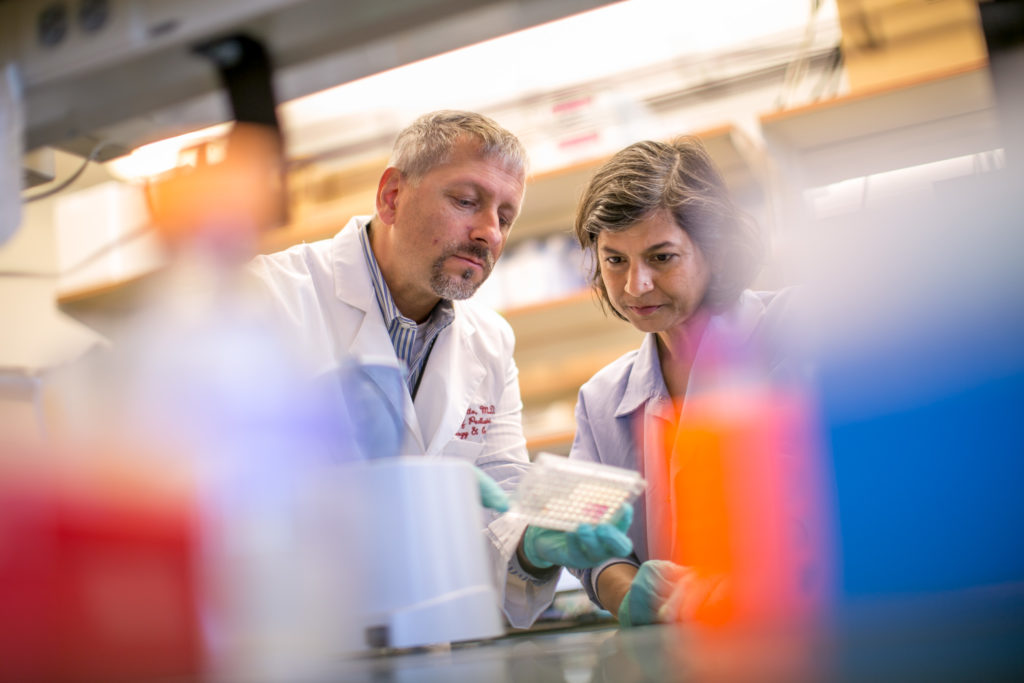Pediatrics Research Week 2020 – Abstract Book
Pediatrics Research Week 2020 – Abstract Book
Pediatrics Research Week 2020 - Abstract Book
File: Pediatrics-Research-Week-2020-Abstract-Book-1.pdfPediatrics Research Week 2020 - Abstract Book
File: Pediatrics-Research-Week-2020-Abstract-Book-1.pdfPediatrics Research Week 2020 – Abstract Book


A study published today in The Lancet Respiratory Medicine journal sheds light on the most common genetic region associated with childhood-onset asthma in African Americans.
“While people of African ancestry tend to have more asthma and more severe asthma than people of European ancestry, studies of genetic risk factors for childhood-onset asthma in African Americans have been inconclusive,” said lead author Carole Ober, PhD, professor and chairman of human genetics at the University of Chicago.
An associated region on chromosome 17 is very large and contains many genes, making it difficult to pinpoint specific genetic variants and specific genes that contribute to asthma risk. In previous studies in Europeans, all the single nucleotide polymorphisms (SNPs) across this region are associated with asthma and with the expression of the same gene or genes. The effects of different SNPs on gene expression, which can differ between tissues, can’t be separated.
The new study addressed these two challenges by focusing on African Americans and on gene expression in multiple tissues that are relevant to asthma: blood immune cells, upper airway (nasal) epithelial cells and lower airway (lung) epithelial cells. Because chromosomes of African ancestry are older than those of European ancestry, the pieces of chromosomes harboring SNPs associated with diseases are much smaller in African Americans.
The study shows SNPs associated with asthma in African Americans regulate the expression of the GSDMB gene in both upper and lower airway cells. In contrast, the SNPs regulating the expression of genes in blood cells are not central to asthma risk.
The researchers did a genetic association study and meta-analysis of the 17q12-21 SNPs for childhood-onset asthma in 5,916 European American and 3,904 African American children, which included children participants in birth cohorts from Children’s Respiratory and Environmental Workgroup (CREW), led by Dr. James Gern, professor and vice chair of research at the University of Wisconsin Department of Pediatrics. CREW is part of the National Institutes of Health (NIH) Environmental influences on Child Health Outcomes (ECHO) Program.
“If you look across the 17q region,” said Ober, “you find a lot of genotypes that are highly correlated in people of European origin. But in people of African and African American origin, the correlations between SNPs are much fewer. We were the first group to fine map this region in African Americans to find the variants and genes that underlie the association with childhood-onset asthma at this region.”
The study was funded by the NIH and is available to read in The Lancet Respiratory Medicine journal.

1. Ascierto PA, Fox B, Urba W, Anderson AC, Atkins MB, Borden EC, Brahmer J, Butterfield LH, Cesano A, Chen D, de Gruijl T, Dillman RO, Drake CG, Emens LA, Gajewski TF, Gulley JL, Stephen Hodi F, Hwu P, Kaufman D, Kaufman H, Lotze M, McNeel DG, Margolin K, Marincola F, Mastrangelo MJ, Maus MV, Parkinson DR, Romero PJ, Sondel PM, Spranger S, Sznol M, Weiner GJ, Wiggington JM, Weber JS. Insights from immuno-oncology: the Society for Immunotherapy of Cancer Statement on access to IL-6-targeting therapies for COVID-19. J Immunother Cancer. 2020 Apr;8(1). pii: e000878. doi: 10.1136/jitc-2020-000878. No abstract available. PMID: 32300051.
2. Barretto KT, Brockman-Schneider RA, Kuipers I, Basnet S, Bochkov YA, Altman MC, Jarjour NN, Gern JE, Esnault S. Human airway epithelial cells express a functional IL-5 receptor. Allergy. 2020 Apr 4. doi: 10.1111/all.14297. [Epub ahead of print] PubMed PMID: 32246831.
3. Bastos RW, Valero C, Silva LP, Schoen T, Drott M, Brauer V, Silva-Rocha R, Lind A, Steenwyk JL, Rokas A, Rodrigues F, Resendiz-Sharpe A, Lagrou K, Marcet-Houben M, Gabaldón T, McDonnell E, Reid I, Tsang A, Oakley BR, Loures FV, Almeida F, Huttenlocher A, Keller NP, Ries LNA, Goldman GH. Functional Characterization of Clinical Isolates of the Opportunistic Fungal Pathogen Aspergillus nidulans. mSphere. 2020 Apr8;5(2). pii: e00153-20. doi: 10.1128/mSphere.00153-20. PubMed PMID: 32269156; PubMed Central PMCID:PMC7142298.
4. Chan K, Hoon M, Pattnaik BR, Ver Hoeve JN, Wahlgren B, Gloe S, Williams J, Wetherbee B, Kiland JA, Vogel KR, Jansen E, Salomons G, Walters D, Roullet JB, Gibson KM, McLellan GJ. Vigabatrin-Induced Retinal Functional Alterations and Second-Order Neuron Plasticity in C57BL/6J Mice. Invest Ophthalmol Vis Sci. 2020 Feb 7;61(2):17. doi: 10.1167/iovs.61.2.17. PMID: 32053727.
5. Comstock JR, Buhalog B, Peebles JK, Hinshaw MA, Co DO, Arkin LM. Lipoatrophic panniculitis in an adolescent. Pediatr Dermatol. 2020 Mar 20. doi: 10.1111/pde.14127. [Epub ahead of print] PubMed PMID: 32198786.
6. Conway JA, Kharayat P, Sanders RC Jr, Nett S, Weiss SL, Edwards LR, Breuer R, Kirby A, Krawiec C, Page-Goertz C, Polikoff L, Turner DA, Shults J, Giuliano JS Jr, Orioles A, Balkandier S, Emeriaud G, Rehder KJ, Kian Boon JL, Shenoi A, Vanderford P, Nuthall G, Lee A, Zeqo J, Parsons SJ, Furlong-Dillard J, Meyer K, Harwayne-Gidansky I, Jung P, Adu-Darko M, Bysani GK, McCarthy MA, Shlomovich M, Toedt-Pingel I, Branca A, Esperanza MC, Al-Subu AM, Pinto M, Tallent S, Shetty R, Thyagarajan S, Ikeyama T, Tarquinio KM, Skippen P, Kasagi M, Howell JD, Nadkarni VM, Nishisaki A; Ketamine Use for Tracheal Intubation in Critically Ill Children Is Associated With a Lower Occurrence of Adverse Hemodyna [published online ahead of print, 2020 Apr 17]. Crit Care Med. 2020;10.1097/CCM.0000000000004314. doi:10.1097/CCM.0000000000004314.
7. Farrell PM, Rock MJ, Baker MW. The Impact of the CFTR Gene Discovery on Cystic Fibrosis Diagnosis, Counseling, and Preventive Therapy. Genes (Basel). 2020 Apr 8;11(4). doi: 10.3390/genes11040401. Review. PubMed PMID: 32276344.
8. Fujiogi M, Camargo CA Jr, Raita Y, Bochkov YA, Gern JE, Mansbach JM, Piedra PA, Hasegawa K. Association of rhinovirus species with nasopharyngeal metabolome in bronchiolitis infants: A multicenter study. Allergy. 2020 Apr 18. doi:10.1111/all.14326. [Epub ahead of print] PubMed PMID: 32306415.
9. Golenberg N, Squirrell JM, Bennin DA, Rindy J, Pistono PE, Eliceiri KW, Shelef MA, Kang J, Huttenlocher A. Citrullination regulates wound responses and tissue regeneration in zebrafish. J Cell Biol. 2020 Apr 6;219(4). pii:e201908164. doi: 10.1083/jcb.201908164. PubMed PMID: 32328635; PubMed Central PMCID: PMC7147109.
10. Harer MW, Charlton JR, Tipple TE, Reidy KJ. Preterm birth and neonatal acute kidney injury: implications on adolescent and adult outcomes. J Perinatol. 2020 Apr 10;. doi: 10.1038/s41372-020-0656-7. [Epub ahead of print] Review. PMID: 32277164.
11. Horoz ÖÖ, Aslan N, Yildizdaş D, Çoban Y, Sertdemir Y, Al-Subu A. Somatic regional oxygen saturation as an early marker of intra-abdominal hypertension in critically ill children: a pilot study [published online ahead of print, 2020 Feb 25].Turk J Med Sci. 2020;10.3906/sag-1903-201. doi:10.3906/sag-1903-201.
12. Jackson DJ, Busse WW, Bacharier LB, Kattan M, O’Connor GT, Wood RA, Visness CM, Durham SR, Larson D, Esnault S, Ober C, Gergen PJ, Becker P, Togias A, Gern JE, Altman MC. Association of Respiratory Allergy, Asthma and Expression of the SARS-CoV-2 Receptor, ACE2. J Allergy Clin Immunol. 2020 Apr 22. pii: S0091-6749(20)30551-0. doi: 10.1016/j.jaci.2020.04.009. [Epub ahead of print] PubMed PMID: 32333915; PubMed Central PMCID: PMC7175851.
13. Kellom ER, Wolf B, Rice GM, Stepien KE. Reversal of Vision Loss in a 49-Year-Old Man With Progressive Optic Atrophy Due to Profound Biotinidase Deficiency. J Neuroophthalmol.2020 Mar 31. doi: 10.1097/WNO.0000000000000933. [Epub ahead of print]PMID: 32235217DOI:10.1097/WNO.0000000000000933.
14. Kling PJ. Iron Nutrition, Erythrocytes, and Erythropoietin in the NICU: Erythropoietic and Neuroprotective Effects. Neoreviews. 2020 Feb;21(2):e80-e88. doi: 10.1542/neo.21-2-e80. PMID: 32005718.
15. Kohler J, Kelly MM. Addition of Dornase to Intrapleural Fibrinolytic Therapy Is Not Superior to Fibrinolytic Therapy Alone for Otherwise Healthy Children Hospitalized With Empyema. JAMA Pediatr.2020;174(4):323-324. doi:10.1001/jamapediatrics.2019.5910.
16. Kopriva JM, Miller KJ, Legare JM, Noonan KJ. Trevor’s disease of the distal radioulnar joint in achondroplasia. Am J Med Genet A. 2020 Feb29. Doi: 10.1002/ajmg.a.61529.
17. Kwan STC, Kezer CA, Helfrich KK, Saini N, Huebner SM, Flentke GR, Kling PJ, Smith SM. Maternal iron nutriture modulates placental development in a rat model of fetal alcohol spectrum disorder. Alcohol. 2020 May;84:57-66. doi: 10.1016/j.alcohol.2019.11.003. Epub 2019 Nov 14. PMID: 31734307; PMCID: PMC7131893.
18. Lai J, Schnapp BH, Tillman DS, Westergaard M, Hess J, Kraut AS. Use of graded responsibility and common entrustment considerations among United States emergency medicine residency programs. J Educ Eval Health Prof. 2020;17:11. doi: 10.3352/jeehp.2020.17.11. Epub 2020 Apr 20. PMID: 32306707.
19. McAdams RM, Pak D, Lalovic B, Phillips B, Shen DD. Dexmedetomidine Pharmacokinetics in Neonates with Hypoxic-Ischemic Encephalopathy Receiving Hypothermia. Anesthesiol Res Pract. 2020;2020:2582965. doi: 10.1155/2020/2582965. eCollection 2020. PMID: 32158472; PMCID: PMC7060842.
20. Meinen RD, Bauer AS, Devous K, Cowan E. Point-of-care ultrasound use in umbilical line placement: a review. J Perinatol. 2020 Apr;40(4):560-566. doi: 10.1038/s41372-019-0558-8. Epub 2019 Nov 22. Review. PMID: 31758061.
21. Mezu-Ndubuisi OJ, Macke EL, Kalavacherla R, Nwaba AA, Suscha A, Zaitoun IS, Ikeda A, Sheibani N. Long-term evaluation of retinal morphology and function in a mouse model of oxygen-induced retinopathy. Mol Vis. 2020;26:257-276. eCollection 2020. PMID: 32256029; PMCID: PMC7127927.
22. Pampati S, Lowry R, Moreno MA, Rasberry CN, Steiner RJ. Having a Sexual Photo Shared Without Permission and Associated Health Risks: A Snapshot of Nonconsensual Sexting. JAMA Pediatr. 2020 Mar 23;. doi: 10.1001/jamapediatrics.2020.0028. [Epub ahead of print] PubMed PMID: 32202601; PubMed Central PMCID: PMC7091371.
23. Pet GC, Eickhoff JC, McNevin KE, Do J, McAdams RM. Risk factors for peripherally inserted central catheter complications in neonates. J Perinatol. 2020 Apr;40(4):581-588. doi: 10.1038/s41372-019-0575-7. Epub 2020 Jan 7. PMID: 31911643.
24. Sandri BJ, Lubach GR, Lock EF, Georgieff MK, Kling PJ, Coe CL, Rao RB. Early-Life Iron Deficiency and Its Natural Resolution Are Associated with Altered Serum Metabolomic Profiles in Infant Rhesus Monkeys. J Nutr. 2020 Apr 1;150(4):685-693. doi: 10.1093/jn/nxz274. PMID: 31722400; PMCID: PMC7138653.
25. Schauberger E, Biagini Myers JM, He H, Martin LJ, Arshad SH, Kurukulaaratchy R, Khurana Hershey GK. Use of the Pediatric Asthma Risk Score to predict allergic and nonallergicasthma. Ann Allergy Asthma Immunol. 2020 Mar 20. pii: S1081-1206(20)30154-X. doi: 10.1016/j.anai.2020.03.010. [Epub ahead of print]PubMed PMID: 32201305
26. Schmuhl NB, Mooney KE, Zhang X, Cooney LG, Conway JH, LoConte NK. No association between HPV vaccination and infertility in U.S. females 18-33 years old. [published online ahead of print, 2020 Apr 3].Vaccine. 2020;S0264-410X(20)30414-X. doi:10.1016/j.vaccine.2020.03.035.
27. Verboon JM, Mahmut D, Kim AR, Nakamura M, Abdulhay NJ, Nandakumar SK, Gupta N, Akie TE, Geddis AE, Manes B, Kapp ME, Hofmann I, Gabriel SB, Klein DE, Williams DA, Frangoul HA, Parkhurst SM, Crane GM, Cantor AB, Sankaran VG. Infantile Myelofibrosis and Myeloproliferation with CDC42 Dysfunction. J Clin Immunol. 2020 Apr 17. doi: 10.1007/s10875-020-00778-7. [Epub ahead of print]. PMID: 32303876.
28. Von Bergen NH, Anagnostopoulos PV. Commentary: What is invisible to the eye could be seen through the heart: How advancements to the visualization of the conduction tissue can improve surgical and electrophysiology procedures. J Thorac Cardiovasc Surg. 2020 Mar 9;. doi: 10.1016/j.jtcvs.2020.02.091. [Epub ahead of print] PMID: 32279964.
29. Wiesner DL, Merkhofer RM, Ober C, Kujoth GC, Niu M, Keller NP, Gern JE, Brockman-Schneider RA, Evans MD, Jackson DJ, Warner T, Jarjour NN, Esnault SJ, Feldman MB, Freeman M, Mou H, Vyas JM, Klein BS. Club Cell TRPV4 Serves as a Damage Sensor Driving Lung Allergic Inflammation. Cell Host Microbe. 2020 Apr 8;27(4):614-628.e6. doi: 10.1016/j.chom.2020.02.006. Epub 2020 Mar 3. PubMed PMID: 32130954.
30. Wooldridge AR, Carayon P, Hoonakker P, Hose B, Eithun B, Brazelton T 3rd, Ross J, Kohler JE, Kelly MM, Dean SM, Rusy D, Gurses AP. Work system barriers and facilitators in inpatient care transitions of pediatric trauma patients. Appl Ergon.2020 May;85:103059. doi: 10.1016/j.apergo.2020.103059. Epub 2020 Feb 12.


In response to COVID-19, the Department of Pediatrics’ annual Research Week will offer alternative programming to spotlight the scholarly work from its residents, fellows, faculty and staff. Through a mix of livestreamed lectures and interactive sessions, Research Week’s celebration of scholarship will be virtually available to the University of Wisconsin School of Medicine and Public Health community and anyone interested in the latest advances in pediatric research.
Activities for the week include small group sessions with faculty and trainees to discuss research careers and how to turn an idea into a research project, the distinguished Gerard B. Odell Lecture, a Faculty Research Forum, platform presentations, and an online poster session featuring the research of residents, fellows, faculty and staff. New this year, up to 10 hours of continuing medical education (CME) credit can be earned by attending the lectures.
A brief outline of the week’s activities is below.
| Tuesday, May 26, 2020 Opening Lecture: What Everyone Needs to Know About Quality Improvement, Informatics and Turning an Idea into a Project 8:00-9:00am | Livestreamed via Blackboard Collaborate 1 CME Credit Available* Presenters: James Gern, MD, Jennifer Rehm, MD, Michael Semanik, MD and Kristin Shadman, MD |
| Wednesday, May 27, 2020 Morning Conference Lecture: Research as a Career Choice 8:00-9:00am | Livestreamed via Blackboard Collaborate 1 CME Credit Available* Presenter: Anne Marie Singh, MD |
| Thursday, May 28, 2020 Gerard B. Odell Lecture and Grand Rounds Presentation 7:30-8:30am | Livestreamed via Blackboard Collaborate 1 CME Credit Available* Presenter: Katryn Furuya, MD The Odell Lecture is named for Gerard B. Odell, MD, who directed the Department of Pediatrics’ Division of Gastroenterology and Nutrition from 1976 through 1991. Dr. Odell was internationally recognized for his research in the field of neonatal jaundice and bilirubin metabolism, and was highly influential in improving the quality of care for newborns and children with liver disease. The Gerard B. Odell Research Award is given to an assistant or associate professor of pediatrics in recognition of outstanding research accomplishments and demonstrated potential for future contributions. Dr. Pelin Cengiz (Associate Professor (CHS), Division of Critical Care) will be presented with this year’s Gerard B. Odell Research Award. Department of Pediatrics Faculty Research Forum – New! 8:55am-12:00pm | Livestreamed via Blackboard Collaborate Up to 3 CME Credits Available* This session will feature ten research vignettes from Department of Pediatrics faculty who were asked to describe one of their favorite projects. Each presentation will last ten minutes and include an additional five minutes for questions and open discussion. The session will be a great opportunity to learn about exciting new developments in child health research. More details on each presentation will be available on our website. Academic Research Town Hall 12:00-12:30pm | Livestreamed via Blackboard Collaborate Drs. Bikash Pattnaik and James Gern will lead a discussion on mechanisms to promote collaborative research. |
| Friday, May 29, 2020 Research Week Keynote Lecture: “How I Became Interested in Pediatrics Research” and Platform Presentations 1:00-3:00pm | Livestreamed via Blackboard Collaborate Up to 2 CME Credits Available* The Research Week Keynote Lecture will be presented by Pelin Cengiz, MD. The lecture will be followed by presentations from two residents, two fellows, and two faculty members. The platform presentations were selected by the Research Week Planning Committee. Online Poster Session and Presentations 3:00-5:00pm | Livestreamed via Blackboard Collaborate Up to 1.5 CME Credits Available* Research posters will be presented online by residents, fellows, faculty and staff. Starting at 3:30pm, brief presentations by each researcher will be delivered via Blackboard Collaborate. |




Congratulations to Yury Bochkov, PhD, who was recently awarded an R01 grant from the National Institutes of Health/National Institute of Allergy and Infectious Diseases (NIH/NIAID) for his project titled “Mechanisms of Enhanced Neutralizing Antibody Responses to Rhinovirus C.” This five-year, $3.9 million award will allow Dr. Bochkov, along with Co-Investigators James Gern, MD and Daniel Jackson, MD, as well as Ronald Gangnon, PhD, from the Departments of Biostatistics and Medical Informatics and Population Health Sciences, to identify host and viral determinants of neutralizing antibody responses, determine antigenic cross-reactivity between rhinovirus C (RV-C) types, and map major neutralizing immunogenic epitopes. The ultimate goal of this project is to enable formulation of a broadly protective multivalent RV-C vaccine, to be used in the prevention and treatment of wheezing illnesses and exacerbations of asthma in young children.


The following scholarly articles were published by Department of Pediatrics faculty and staff during February 2020:


The following scholarly articles were published by Department of Pediatrics faculty and staff during January 2020:
Lectures by the 2018 and 2019 Gerard B. Odell Research Award winners, along with rows of research posters filling the Health Sciences Learning Center (HSLC) were among the highlights of the Department of Pediatrics’ 2019 Spring Research Week, held May 28-31, 2019.
On Thursday, May 30, David McCulley, MD (Assistant Professor, Division of Neonatology and Newborn Nursery), gave the 2019 Gerard B. Odell Lecture and Grand Rounds presentation, “Clinical and Basic Research Advances for Congenital Diaphragmatic Hernia.” (View video)
A congenital defect that occurs in one of every 3,500 live births, CDH is associated with impaired lung and pulmonary vascular development and function. Depending on severity, it has a 20 to 50 percent mortality rate.
At UW Health, Dr. McCulley and a multidisciplinary team created a standardized postnatal treatment protocol for CDH that over the past four years, improved survival and decreased the need for extracorporeal membrane oxygenation (ECMO). The team is currently investigating how the use of innovative ventilation techniques and bridled nastrogastric tubes can reduce the length of hospital stays and the need for gastrostromy tube placement in newborns with CDH.
Dr. McCulley then shifted his presentation into a discussion of the genetic mechanisms of CDH, which are poorly understood and the focus of his basic science research program.
He explained how a gene, pre-B-cell leukemia factor (Pbx1), which is required for diaphragm formation, controls postnatal growth of lung alveoli and pulmonary vasculature. He shared his recently published research showing that newborn mice without this gene fail to thrive after birth, die within two to three weeks, and have underdeveloped lungs, cardiac hypertrophy and pulmonary hypertension.
In addition, mice without a protein-coding gene called SIN3A also have abnormal diaphragm development, underdeveloped lungs, lung hypoplasia and pulmonary hypertension.
Dr. McCulley recently received his first R01 award from the National Institutes of Health National Heart, Lung, and Blood Institute to further study how these genetic variations impact the development of CDH.
On Friday, May 31, Christian Capitini, MD (Assistant Professor, Division of Hematology, Oncology and Bone Marrow Transplant), presented the 2018 Odell Lecture and Research Day keynote address, “Unlocking the Physician-Scientist-Educator-Advocate Within.”
He reflected on how his career path as a cancer researcher began in high school, as a participant in a summer science research internship program. For the next 14 years, as he completed college, medical school, residency and fellowship training, he wove basic science research into each phase of his education. After serving for three years as an instructor at the National Cancer Institute, he joined the faculty of the Department of Pediatrics in 2011 as an assistant professor.
After explaining how graft-versus-host disease remains one of the key challenges in using allogeneic bone marrow transplant to treat childhood cancer, Dr. Capitini recalled how the 2013 creation of the Stand Up to Cancer/St.Baldrick’s Foundation Dream Team influenced his career. The Dream Team brought together scientists at the University of Wisconsin Carbone Cancer Center (including himself and his mentor, Paul Sondel, MD, PhD), and those from six other North American cancer centers to team up and develop new immune-based therapies for childhood cancer.
At UW-Madison, that award resulted in lab research on using natural-killer cells to target and treat neuroblastoma, resulting in Dr. Capitini’s first R01 award, and clinical research on using CAR T therapy for B-cell acute lymphoblastic leukemia. In 2017, the U.S. Food and Drug Administration approved the use of CAR T-cell therapy on select patients; today, American Family Children’s Hospital is one of over 50 sites certified to administer CAR T cells, largely through Dr. Capitini’s leadership.
Dr. Capitini then shared an acronym he read about that he considers to be the keys to a successful career in academic medicine: commitment, organization, mentorship, information and communication (or COMIC, for short).
He encouraged residents and fellows to start out by writing case reports or invited reviews, networking at national meetings, working in a lab, and writing and publishing research results.
And for those not yet certain of their career path, he closed with examples of less traditional careers in pediatrics, including government positions, serving as an expert witness or advising on public policy. He also emphasized maintaining a good work-life balance.
Research Day continued with six oral presentations:
It also included 80 abstracts by faculty, fellows, residents and students on display as posters in the HSLC atrium throughout Friday afternoon. Of these, 31 (39%) had been presented at April’s Pediatric Academic Societies (PAS) meeting: 28 as poster presentations and three as platform presentations.
Other activities during Research Week included a panel discussion on scholarly approaches to quality improvement; a lecture by Norman Fost, MD (Professor Emeritus, Division of Child Protection and Bioethics) on ethical considerations in pediatric research; and a presentation by James Gern, MD (Vice Chair for Research and Chief, Division of Allergy, Immunology and Rheumatology) and Kim Stevenson (Assistant Director of Research) on important updates in research proposal development and submission.
The Odell Lecture is named for Gerard B. Odell, MD, who directed the Department of Pediatrics’ Division of Gastroenterology and Nutrition from 1976 through 1991. Dr. Odell was internationally recognized for his research in the field of neonatal jaundice and bilirubin metabolism, and was highly influential in improving the quality of care for newborns and children with liver disease.
The Gerard B. Odell Research Award is given to an assistant or associate professor of pediatrics in recognition of outstanding research accomplishments and demonstrated potential for future contributions.


The National Institutes of Health (NIH) awarded the Children’s Respiratory and Environmental Workgroup (CREW) $68,808,597 for five years to continue collecting standardized data from 10 birth cohorts around the country to better understand environmental causes of allergic diseases and asthma.
The University of Wisconsin-Madison serves as CREW’s Administrative Center and Biomedical Informatics and Biostatistical Center. The multicenter project is a collaboration between investigators in the UW Department of Pediatrics (PI James Gern, MD; co-investigators Christine Seroogy, MD; Daniel Jackson, MD; Robert Lemanske, MD; Anne Marie Singh, MD; and project manager Gina Crisafi) and the Institute for Clinical and Translational Research (Umberto Tachinardi, MD; Mark Craven, PhD; Eneida Mendonca, MD, PhD; and Robert Lemanske, MD).
CREW is part of the NIH Environment and Child Health Outcomes (ECHO) consortium, and will also collect information about obesity, neurocognitive development and perinatal outcomes. The application was supported by additional funding from the UW Department of Pediatrics, the UW School of Medicine and Public Health, the UW Institute for Clinical and Translational Research and the UW-Madison Office of the Vice Chancellor for Research and Graduate Education.